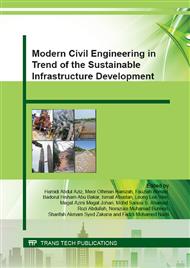[1]
F. Goodarzi, Environmental Asessment of Bottm Ash from Canadian Coal-Fired Power Plants. The open Env. & Biol. Mon. Jour. 2 (2009) 1-10.
Google Scholar
[2]
B. Diana, B. Girts, U. Liga, Coal Combustion Bottom Ash as Microfiller with Pozzolanic Properties for Traditional Concrete. 11th International Conference on Modern Building Materials, Structures and Techniques, MBMST. Procedia Engineering. 57 (2013).
DOI: 10.1016/j.proeng.2013.04.022
Google Scholar
[3]
A. Umar Abubakar, K.S. Baharudin, Potential Use of Malaysian Thermal Power Plants Coal Bottom Ash in Construction. Int. Journal of Sustainable Construction Engineering & Technology. 3(2) (2012) 25-37.
Google Scholar
[4]
B. Juric, L. Hanzic, R. Ilic, N. Samec, Utilization of municipal solid waste bottom ash and recycled aggregate in concrete. Waste Management. 26 (2006) 1436-1442.
DOI: 10.1016/j.wasman.2005.10.016
Google Scholar
[5]
T. Magialardi, A.E. Paolini, A. Polettini, P. Sarini, Optimization of the solidification/stabilization process of MSW fly ash in cementitious matrices. J. Hazard Mater. B70 (1999) 53-70.
DOI: 10.1016/s0304-3894(99)00132-6
Google Scholar
[6]
M. Djuric, J. Ranogajec, R. Omorjan, S. Miletic, Sulfate corrosion ofPortland cement—pure and blended with 30% of fly ash, Cem. Concr. 26 (1996) 1295– 1300.
DOI: 10.1016/0008-8846(96)00127-5
Google Scholar
[7]
A. Palomo, M.W. Grutzeck, M.T. Blanco, Alkali-activated fly ashes, a cement for future. Cem. Concr. Res. 29 (1999) 983-987.
DOI: 10.1016/s0008-8846(98)00243-9
Google Scholar
[8]
M. Cheriaf, J. Calvalcante Rocha, J. Pera, Pozzolanic properties of pulverized coal combustion bottom ash. Cem. Concr. Res. 29 (1999) 1387-1391.
DOI: 10.1016/s0008-8846(99)00098-8
Google Scholar
[9]
I. Kula, A. Olgunb, V. Sevincc, Y. Erdogan, An investigation on the use of tincal ore waste, fly ash, and coal bottom ash as Portland cement replacement materials. Cement and Concrete Research 32 (2002) 227–232.
DOI: 10.1016/s0008-8846(01)00661-5
Google Scholar
[10]
S.A. Barbhuiya, et al. Properties of fly ash concrete modified with hydrated lime and silica fume. Construction and Building Materials, 23 (2009) 3233–3239.
DOI: 10.1016/j.conbuildmat.2009.06.001
Google Scholar
[11]
ASTM C150 Standard Specification for Portland Cement. American Society for Testing and Materials, West Conshohocken, Pennsylvania (2012).
Google Scholar
[12]
N.M. Altwair, M.A. Megat Johari, S.F. Saiyid Hashim, Influence of treated palm oil fuel ash on compressive properties and chloride resistance of engineered cementitious composites. Materials and Structures. 47 (2014) 667-682.
DOI: 10.1617/s11527-013-0087-4
Google Scholar
[13]
ASTM C 618 Standard Specification for Coal Fly Ash and Raw or Calcined Natural Pozzolan for use in Concrete. West Conshohocken, Pennsylvania (2012).
DOI: 10.1520/c0618-00
Google Scholar
[14]
ASTM C 778-02 Standard Specification for Standard Sand. American Society for Testing and Materials, West Conshohocken, Pennsylvania (2003).
Google Scholar
[15]
S. Naganathan, L. Tan, Effect of Fly Ash Fineness on the Performance of Cement Mortar. Jordan Journal of Civil Engineering, 7(3) (2013) 326-331.
Google Scholar
[16]
M.A. Megat Johari, A.M. Zeyad, N. Muhamad Bunnori, K.S. Ariffin, Engineering and transport properties of high-strength green concrete containing high volume of ultra-fine palm oil fuel ash. Construction and Building Materials. 30 (2012) 281-288.
DOI: 10.1016/j.conbuildmat.2011.12.007
Google Scholar
[17]
C.B. Cheah, M. Mahyuddin Ramli., Optimization of Mix Proportion of High Performance Mortar for Structural Applications. American J. of Engineering and Applied Sciences. 3 (4) (2010) 643-649.
DOI: 10.3844/ajeassp.2010.643.649
Google Scholar
[18]
ASTM C109 / C109M – 13 Standard Test Method for Compressive Strength of Hydraulic Cement Mortars (Using 2-in. or [50-mm] Cube Specimens) (2013).
DOI: 10.1520/c0109_c0109m-20
Google Scholar


